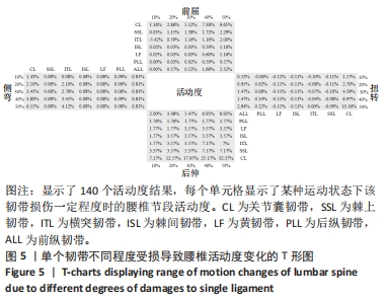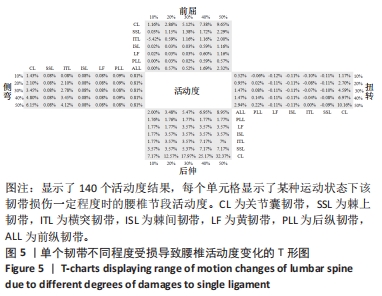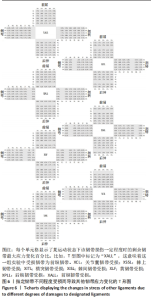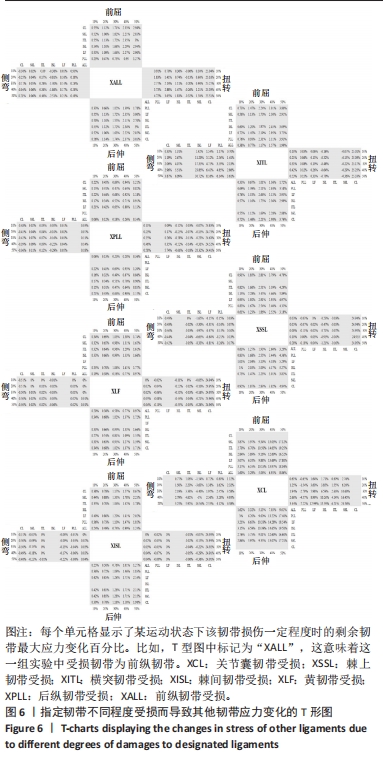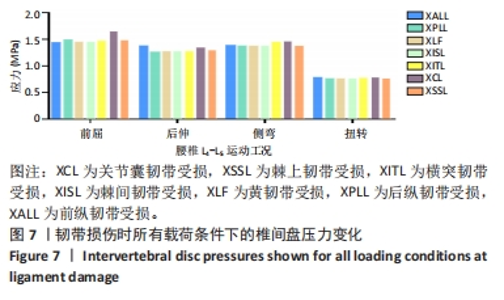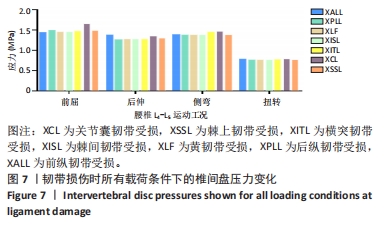[1] SHARMA M, LANGRANA NA, RODRIGUEZ J. Role of ligaments and facets in lumbar spinal stability. Spine (Phila Pa 1976). 1995;20(8): 887-900.
[2] GILLESPIE KA, DICKEY JP. Biomechanical role of lumbar spine ligaments in flexion and extension: determination using a parallel linkage robot and a porcine model. Spine (Phila Pa 1976). 2004; 29(11):1208-1216.
[3] 杨雄.基于韧带损伤腰椎力学失稳模型的建立与应用[D].重庆:重庆大学,2019.
[4] HEUER F, SCHMIDT H, KLEZL Z, et al. Stepwise reduction of functional spinal structures increase range of motion and change lordosis angle. J Biomech. 2007;40:271-280.
[5] HEUER F, SCHMIDT H, CLAES L, et al. Stepwise reduction of functional spinal structures increase vertebral translation and intradiscal pressure. J Biomech. 2007;40:795-803.
[6] 吴聪聪. 胸腰段脊柱后方韧带复合体序贯损伤对其稳定性的有限元分析[D]. 温州:温州医科大学,2019.
[7] NG HW, TEO EC, ZHANG Q. Influence of cervical disc degeneration after posterior surgical techniques in combined flexion-extension - a nonlinear analytical study. J Biomech Eng. 2005;127(1):186-192.
[8] MACKERLE J. Finite element modeling and simulations in orthopedics: a bibliography 1998-2005. Comput Methods Biomech Biomed Eng. 2006;9(3):149-199.
[9] SCHMIDT H, HEUER F, DRUMM J, et al. Application of a calibration method provides more realistic results for a finite element model of a lumbar spinal segment. Clin Biomech (Bristol, Avon). 2007;22(4):377-384.
[10] BOWDEN AE, GUERIN HL, VILLARRAGA ML, et al. Quality of motion considerations in numerical analysis of motion restoring implants of the spine. Clin Biomech (Bristol, Avon). 2008;23(5):536-544.
[11] AYTURK UM, PUTTLITZ CM. Parametric convergence sensitivity and validation of a finite element model of the human lumbar spine. Comput Methods Biomech Biomed Eng. 2011;14(8):695-705.
[12] UENO K, LIU YK. A three dimensional nonlinear finite element model of lumbar interverbral joint in torsion. J Biomech(Eng). 1987;109:200-209.
[13] GUDAVALLI MR, TRIANO JJ. An analytical model of lumbar motion segment in flexion. J Manipulative Physiol Ther. 1999; 22(4):201-208.
[14] BERMEL EA, BAROCAS VH, ELLINGSON AM. The role of the facet capsular ligament in providing spinal stability. Comput Methods Biomech Biomed Engin. 2018;21(13):712-721.
[15] ALEXANDER T, NIKOALOS M, SAVVAS S, et al. A finite element model technique to determine the mechanical response of a lumbar spine segment under complex loads. Journal of Applied Biomechanics. 2012;28:448-456.
[16] PANJABI MM, GOEL VK, TAKATA K. Physiologic strains in the lumbar spinal ligaments. An in vitro biomechanical study 1981 volvo award in biomechanics. Spine. 1982;7(3):192-203.
[17] ZANDER T, ROHMANN A, BERGMANN G. Analysis of simulated single ligament transection on the mechanical behaviour of a lumbar functional spinal unit. Biomed Tech. 2004;49(1-2):27-32.
[18] HOPKINS TJ, WHITE AA, 3RD. Rehabilitation of athletes following spine injury. Clin Sports Med. 1993;12(3):603-619.
[19] GUO LX, LI WJ. A biomechanical investigation of thoracolumbar burst fracture under vertical impact loads using finite element method. Clin Biomech. 2019;68:29-36.
[20] AFFOLTER C, KEDZIERSKA J, VIELMA T, et al. Estimating lumbar passive stiffness behaviour from subject-specific finite element models and in vivo 6DOF kinematics. J Biomech . 2020;102:109681.
[21] HSIEH YY, KUO YJ, CHEN CH, et al. Biomechanical Assessment of Vertebroplasty Combined with Cement-Augmented Screw Fixation for Lumbar Burst Fractures: A Finite Element Analysis. Appl Sci Basel. 2020; 10(6):14.
[22] 张文,王兰,施勤,等.腰椎行椎间孔入路椎间融合术固定的有限元分析[J].医用生物力学,2014,29(5):405-410.
[23] RASTEGAR S, ARNOUX PJ, WANG XY, et al. Biomechanical analysis of segmental lumbar lordosis and risk of cage subsidence with different cage heights and alternative placements in transforaminal lumbar interbody fusion. Comput Methods Biomech Biomed Eng. 2020;23(9): 456-466.
[24] GILLESPIE KA, DICKEY JP. Biomechanical role of lumbar spine ligaments in flexion and extension: Determination using a parallel linkage robot and a porcine model. Spine. 2004;29(11):1208-1216.
[25] 方新果,赵改平,王晨曦,等. 基于CT图像腰椎L4~L5节段有限元模型建立与分析[J].中国生物医学工程学报,2014,33(4):487-492.
[26] 王宏卫,刘新宇,万熠.人体腰椎L4-L5段有限元模型建立及力学有效性验证[J].医学与哲学(B),2017,38(5):50-53.
[27] 颜文涛,赵改平,方新果,等.人体腰椎L(4~5)节段有限元建模及分析[J].生物医学工程学杂志,2014,31(3):612-618.
[28] 蒋强,丁宇,刘金玉,等.有限元模拟全内镜下精准椎板开窗减压术及生物力学分析[J]. 中国组织工程研究,2020,24(12):1891-1896.
[29] OXLAND TR, LIN RM, PANJABI MM. Three‐dimensional mechanical properties of the thoracolumbar junction. J Orthop Res. 1992;10:573-580.
[30] QIU TX, TEO EC, ZHANG QH. Effect of bilateral facetectomy of thoracolumbar spine T11–L1 on spinal stability. Med Biol Eng Comput. 2006;44:363-370.
[31] 庞胤,尹帅,张海峰,等. 退变对腰椎4-5节段椎间盘生物力学的影响[J]. 山东医药,2021,61(4):55-57.
[32] ALAPAN Y, DEMIR C, KANER T, et al. Instantaneous center of rotation behavior of the lumbar spine with ligament failure. J Neurosurg Spine. 2013;18:617-626.
[33] 牛陆,李娜,柳茵,等.后纵韧带硬化对颈椎力学影响的三维有限元分析[J]. 北京生物医学工程,2018,37(1):40-50.
[34] WIDMER J, ETH MSC, CORNAZ F, et al. Biomechanical contribution of spinal structures to stability of the lumbar spine-novel biomechanical insights. Spine. 2020;20(10):1705-1716.
[35] ELLINGSON AM, SHAW MN, GIAMBINI H, et al. Comparative role of disc degeneration and ligament failure on functional mechanics of the lumbar spine. Comput Methods Biomech Biomed Engin. 2016; 19(9):1009-1018.
[36] NASERKHAKI S, ARJMAND N, SHIRAZI-ADL A, et al. Effects of eight different ligament property datasets on biomechanics of a lumbar L4-L5 finite element model. J Biomech. 2018;70:33-42.
[37] GREGORY A, FORELL V, ANTON E, et al. Biomechanical implications of lumbar spinal ligament transection.Comput Methods Biomech Biomed Eng. 2014; 17(15): 1685-1695.
[38] 付方达,邵晶奕,童培建,等.脊柱轴线力学失稳诱导椎间盘退变小鼠模型的建立及评价[J].中国中医骨伤科杂志,2020,28(1):1-7.
[39] 黄河,李宁宁,胡朝晖,等.纤维环穿刺法与腰椎失稳法建立椎问盘退变模型[J].中国现代医生,2011,49(16):22-24. |
